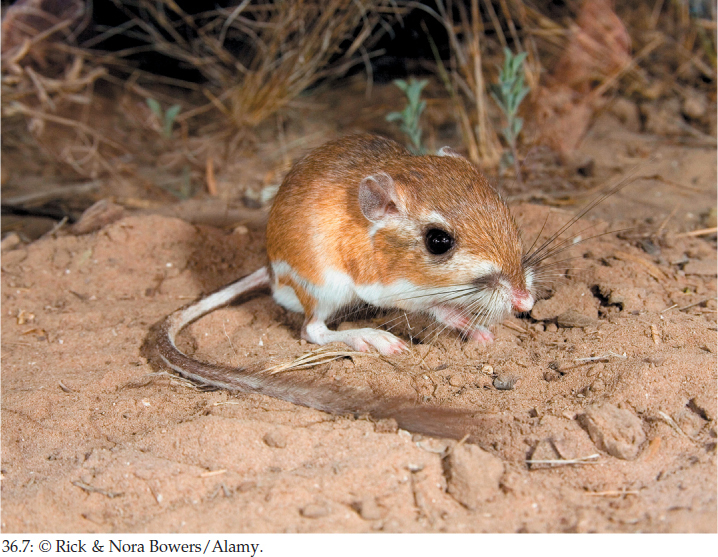CONCEPT36.4 Dehydration Is the Principal Challenge for Terrestrial Animals
Water balance and the risk of dehydration make up the single greatest challenge that terrestrial animals face. We all know that water spilled on a table will gradually disappear by evaporation as it forms gaseous water vapor in the air. Likewise, the internal body fluids of animals on land also tend to evaporate—a process that can concentrate the body fluids and reduce their volume.
The normal blood osmotic pressure of terrestrial vertebrates is typically 300–350 mOsm. The early ancestors of terrestrial vertebrates were freshwater fish with similar osmotic pressures, as noted in Concept 36.3. Amphibians, reptiles (including birds), and mammals—including us—retain osmotic pressures in this range.
Humidic terrestrial animals have rapid rates of water loss that limit their behavioral options
During the early stages of animal evolution, the body coverings of animals were relatively permeable to water. This is understandable, because animals spent their early evolution in aquatic environments. Because of their aquatic history, animals had body coverings that were highly water-permeable when they emerged onto land.
Today, some terrestrial animals—classed as humidic—continue to have outer body coverings that are highly permeable to water. Examples include millipedes, centipedes, land snails (except when they are withdrawn into their shells), and most amphibians. Water evaporates across the skin of a leopard frog at a rate similar to that of evaporation from an open water surface!
Although humidic animals live on land, they are not free to expose themselves continually to the open air. Their behavioral options are limited because they lose water so rapidly in the open air that if they are forced to remain there, they die within tens of minutes or a few hours. Humidic animals have two options. One is to stay in places where the humidity of the air is high, such as in thick grass or under logs. Their other option is to limit the time they spend in dehydrating situations and return often to places where they can rehydrate. A frog, for instance, might hop out into an open, sunlit area where there are lots of insects to eat, and it might stay there for a short while. A frog loses water rapidly in such a situation, however, and must soon return to a place, such as a pond edge, where it can replenish its body water.
Xeric terrestrial animals have low rates of water loss, giving them enhanced freedom of action
The terrestrial animals we’re accustomed to seeing out in the open typically have body coverings that protect them from high rates of evaporative water loss. We see birds, snakes, lizards, mammals, insects, and spiders. All have evolved body coverings in which layers of lipids—waxy or greasy materials—prevent water in their body fluids from freely evaporating into the air. With this protection, these animals—termed xeric—can spend indefinite periods in the open air.
Mammals, birds, and other xeric vertebrates have lipids in the outermost cellular layers of their skin. Insects and spiders have a thin layer of lipids on the outside of their exoskeleton.
LINK
See Concept 23.6 for more on the adaptations that allowed animals to colonize dry environments
Some xeric animals are adapted to live in deserts
A desert, by definition, is a terrestrial environment that receives so little rain that the availability of water exerts a dominant, controlling influence on the organisms living there. Animals adapted to live in deserts exploit multiple mechanisms for reducing their rates of water loss, so that they have very low water requirements.
Kangaroo rats (FIGURE 36.7) and a variety of other desert rodents have such low rates of water loss that when individuals finish nursing from their mother, most never drink again for the rest of their lives. How is this possible? These animals have multiple adaptations that reduce their rate of water loss:
- They live in deep, cool burrows during the heat of the day.
- They have exceptionally low rates of evaporation through their skin and produce dry feces.
- Their kidneys can produce urine 10–20 times more concentrated than their blood plasma (osmotic U/P = 10–20), the highest values known among all animals. By concentrating their urine to such a great extent, the animals can excrete their soluble wastes with very little water loss.

760
Desert rodents do need some water. Where does it come from? Kangaroo rats typically eat air-dried plant parts such as seeds. These provide a little water. The most important source of water for kangaroo rats, however, is the H2O produced by the oxidation of organic molecules during metabolism (see Concept 6.2). This water is called metabolic water or oxidation water. All animals produce metabolic water, but it is important in the water budget only in animals that conserve water exceptionally well.
Many insects are also adapted outstandingly well to living in deserts. Some birds and mammals survive in deserts by eating the juicy bodies of desert insects or the leaves of juicy plants.
LINK
Plants that live in deserts also face numerous challenges; their adaptations to desert life are described in Concept 28.3
CHECKpointCONCEPT36.4
- What is metabolic water?
- Dromedary camels have kidneys that can produce urine eight times more concentrated than their blood plasma. The average concentrating ability of mammals of similar body size is about half as great. Why would camels benefit from having a higher concentrating ability than average?
- Humidic and xeric terrestrial animals differ in behavior because of their contrasting abilities to conserve body water. Speaking in broad terms, how do they differ in behavior, and why?
In the last two concepts we have considered ways in which aquatic and terrestrial animals meet the challenges they face in their environments. Earlier we stressed that the concentration and volume of an animal’s urine are major considerations for understanding water and salt balance. To close the chapter, we will now examine how kidneys work and the characteristics of the urine they produce.